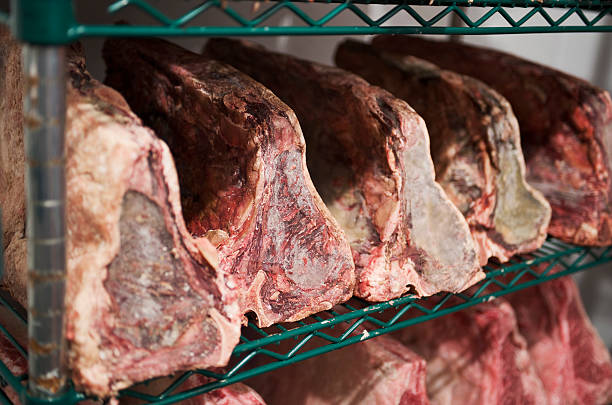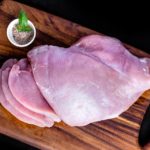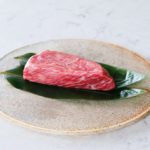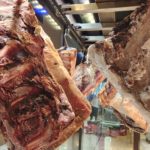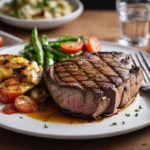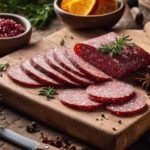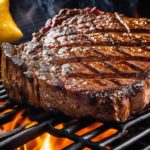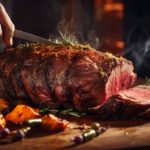Are you a steak enthusiast struggling to find the ultimate indulgence? I’ve been there too. After conducting some research, I discovered that dry-aged prime rib holds the key to an unparalleled steak experience.
This blog is your comprehensive guide on why dry-aged prime rib is such a game-changer for meat lovers, explaining everything from how beef aging works to its effects on flavor and texture – did you know it involves 4-6 weeks of aging in specific temperature and humidity for enhanced tenderness? Stick around, this juicy read could revolutionize your steak dinners!
Key Takeaways
- Dry-aged prime rib is a game-changer for steak enthusiasts, offering unparalleled flavor and tenderness.
- The process of dry aging involves exposing the beef to controlled temperature and humidity levels in a refrigerated room for 4-6 weeks, resulting in increased tenderness and concentrated flavors.
- Dry – aged prime rib has a unique texture that is both tender and slightly firm, giving it a satisfying mouthfeel.
- You can find dry-aged prime rib at specialty butcher shops, online meat retailers, and high-end steakhouses.
What is Dry Aging and How Does it Work?
Dry aging is a process where beef is exposed to controlled temperature and humidity levels in a refrigerated room, allowing natural enzymes to break down the connective tissue and muscle fibers, resulting in increased tenderness and concentrated flavors.
Process of dry aging
Aging your steak is not hard. Here is how dry aging works:
- The cut of beef gets a spot in a fridge. Each piece has its own room.
- The fridge must be cool and damp but not too cold or wet.
- The meat must stay in the fridge for 4 – 6 weeks.
- In those weeks, the beef loses some water. This makes the flavor stronger.
- The outside of the beef turns hard and dries out.
- Muscle fibers break down from the inside making it softer.
Effects on taste and texture
Dry aging has a significant impact on the taste and texture of prime rib, making it an exceptional choice for steak enthusiasts. During the aging process, the beef develops a concentrated flavor that is rich and intense.
The connective tissues in the meat break down, resulting in increased tenderness. This makes each bite incredibly juicy and full of delicious flavor. Additionally, dry-aged prime rib has a unique texture that is both tender and slightly firm, giving it a satisfying mouthfeel.
These effects on taste and texture make dry-aged prime rib the ultimate indulgence for those who appreciate high-quality steak.
Benefits of Dry Aged Prime Rib
Dry aged prime rib offers enhanced flavor and tenderness, with concentrated meaty flavors and a complex nutty and buttery aroma that will leave steak enthusiasts wanting more.
Enhanced flavor and tenderness
Dry-aged prime rib offers an unparalleled eating experience for steak enthusiasts. The process of dry aging creates a steak with enhanced flavor and tenderness that is simply unmatched by other methods.
During the aging process, the meat is exposed to controlled levels of humidity and temperature in a refrigerated room. This allows the connective tissue in the beef to break down, resulting in a more tender and juicy steak.
Additionally, as the meat ages, its natural flavors become concentrated, leading to a more intense and meaty taste that is hard to resist. So if you’re looking for a truly delicious and indulgent steak experience, dry-aged prime rib is definitely worth trying.
Concentrated meaty flavor
Dry-aged prime rib offers a concentrated, meaty flavor that is unmatched by any other steak. The aging process allows the flavors to intensify and develop, resulting in a rich and robust taste.
Every bite of dry-aged prime rib bursts with savory goodness, making it a true indulgence for steak enthusiasts. The controlled environment during the dry-aging process helps to enhance this meaty flavor even further, creating a steak experience that is truly unforgettable.
Once you try dry-aged prime rib, you will understand why it is considered the ultimate choice for those who crave bold and delicious flavors in their meat.
Complex nutty and buttery aroma
The dry aging process gives prime rib a complex nutty and buttery aroma that is simply irresistible. As the beef ages in a controlled environment, it develops these unique flavors that add depth to every bite.
The concentrated nuttiness and buttery notes enhance the overall taste experience, making dry-aged prime rib a true indulgence for steak enthusiasts. With each mouthful, you’ll savor the rich flavors that come from this special aging technique.
How to Cook Dry Aged Prime Rib at Home
Season the dry aged prime rib with a generous amount of salt, pepper, and any other desired seasonings before cooking.
Proper seasoning and preparation
To make the most delicious dry-aged prime rib at home, I have some tips for proper seasoning and preparation:
- Start by selecting a high-quality dry-aged prime rib from a reputable butcher or online meat retailer.
- Before cooking, allow the prime rib to come to room temperature for about 1 hour. This will ensure even cooking.
- Season the prime rib generously with kosher salt and freshly ground black pepper. You can also add other herbs or spices according to your preference, such as garlic powder or rosemary.
- Rub the seasoning into the meat, making sure to cover all sides evenly.
- Let the seasoned prime rib rest for at least 30 minutes before cooking. This allows the flavors to penetrate the meat.
- Preheat your oven to a high temperature, around 450°F (232°C).
- Place the seasoned prime rib on a roasting rack in a roasting pan. This elevates the meat and allows air circulation for even cooking.
- Cook the prime rib at this high temperature for about 15 minutes to sear it and lock in juices.
- After searing, reduce the oven temperature to around 325°F (163°C) and continue cooking until your desired level of doneness. Use a meat thermometer inserted into the thickest part of the meat to check for doneness. Different temperatures correspond to different levels of doneness:
- Medium-rare: 130°F (54°C)
- Medium: 140°F (60°C)
- Medium-well: 150°F (66°C)
- Once cooked, remove the prime rib from the oven and let it rest for about 15 minutes before carving. This allows the juices to redistribute throughout the meat, resulting in tender and juicy slices.
Cooking methods and temperatures
To cook dry-aged prime rib at home, I recommend the following cooking methods and temperatures:
- Preheat your oven to 500°F (260°C) for a nice sear on the outside of the steak.
- Season your dry – aged prime rib generously with salt and pepper, ensuring that it is evenly coated.
- Place the seasoned prime rib on a rack in a roasting pan with the fat side facing up. This allows the fat to baste the meat as it cooks.
- Cook the prime rib at 500°F (260°C) for about 15 minutes to develop a flavorful crust.
- After 15 minutes, reduce the oven temperature to 325°F (163°C) and continue cooking until desired doneness is reached.
- Use a meat thermometer inserted into the thickest part of the steak to check for doneness:
- For rare: Remove from oven when internal temperature reaches 120-125°F (49-52°C).
- For medium-rare: Remove from oven when internal temperature reaches 130-135°F (54-57°C).
- For medium: Remove from oven when internal temperature reaches 140-145°F (60-63°C).
- Once cooked to your desired doneness, remove the prime rib from the oven and let it rest for about 15 minutes before carving.
- Carve thin slices against the grain of the meat for maximum tenderness.
Resting and carving techniques
Resting and carving dry-aged prime rib is crucial to ensure a juicy and flavorful steak. Here are some tips:
- Let the steak rest: After cooking, allow the dry-aged prime rib to rest for about 10-15 minutes. This allows the juices to redistribute throughout the meat, resulting in a tender and moist steak.
- Carve against the grain: Identify the direction of the muscle fibers on the steak and carve against them. This helps to break up any tough connective tissue and makes each bite more tender.
- Use a sharp knife: A sharp knife ensures clean and smooth cuts through the meat, preventing any tearing or shredding.
- Slice to desired thickness: Whether you prefer thick or thin slices, make sure to slice evenly for consistent cooking.
- Serve immediately: Dry-aged prime rib is at its best when served hot and fresh from the oven or grill. Enjoy it with your favorite side dishes for a delicious meal.
Where to Find Dry Aged Prime Rib
You can find dry-aged prime rib at specialty butcher shops, online meat retailers, and high-end steakhouses. Don’t miss out on the ultimate indulgence for steak enthusiasts – read more to discover where to get your hands on this delicious meat!
Specialty butcher shops
I love exploring specialty butcher shops to find the best dry-aged prime rib. These shops are like treasure troves for meat lovers, offering a wide selection of premium cuts that have been carefully aged to perfection.
The butchers at these shops are experts in their craft and can guide you to the perfect cut for your taste preferences. Whether you’re looking for a beautifully marbled ribeye or a melt-in-your-mouth filet mignon, specialty butcher shops are the go-to place for finding top-quality dry-aged beef.
The staff is knowledgeable and passionate about their products, ensuring that you get the best flavor and tenderness in every bite. So next time you want to indulge in a delicious steak experience, make sure to visit your local specialty butcher shop and discover the amazing world of dry-aged prime rib!
Online meat retailers
I love the convenience of shopping for dry-aged prime rib online. There are many reputable meat retailers that offer this indulgent steak right at your fingertips. You can easily browse through their selections and choose the perfect cut of dry-aged prime rib to be delivered straight to your door.
Online meat retailers source high-quality beef and ensure proper aging techniques, so you can trust that you’re getting a flavorful and tender piece of meat every time. It’s a great option for those who don’t have access to specialty butcher shops or want to skip the trip altogether.
Plus, it’s an exciting experience to unwrap your package and reveal the deliciousness inside!
High-end steakhouses
I absolutely love dining at high-end steakhouses because they offer a truly exceptional experience for steak enthusiasts like me. These establishments pride themselves on serving the finest cuts of dry-aged prime rib, which is considered the ultimate indulgence for meat lovers.
The chefs at high-end steakhouses take great care in selecting and aging their beef to ensure maximum flavor and tenderness. They understand that dry-aging is a traditional method of aging beef in a controlled environment with temperature and humidity control.
This process allows the flavors to concentrate and intensify while breaking down connective tissue, resulting in a more tender and flavorful steak. When it comes to finding top-quality dry-aged prime rib, high-end steakhouses are definitely the go-to places where you can indulge yourself in the most delicious and perfectly cooked steak imaginable.
Conclusion
Dry-aged prime rib is the ultimate indulgence for steak enthusiasts because it offers a flavor and tenderness that is unmatched. The process of dry aging creates a concentrated, meaty flavor with a complex nutty and buttery aroma.
Whether you cook it at home or find it at specialty butcher shops or high-end steakhouses, dry-aged prime rib will provide an exceptional dining experience that will satisfy any meat lover’s cravings.
FAQs
1. What is dry-aged prime rib?
Dry-aged prime rib is a high-quality cut of beef that has been aged in a controlled environment for several weeks to enhance its tenderness and flavor.
2. How does dry-aging affect the taste of prime rib?
Dry-aging allows the natural enzymes in the meat to break down, resulting in a more concentrated and intense flavor. It also creates a tender texture and adds nutty, earthy undertones to the meat.
3. Is dry-aged prime rib more expensive than regular steak?
Yes, dry-aged prime rib tends to be more expensive than regular steak due to the additional time and effort required for the aging process. However, many steak enthusiasts believe it is worth the higher price for its exceptional taste and quality.
4. Can I cook dry-aged prime rib at home?
Yes, you can cook dry-aged prime rib at home! However, it’s important to follow proper cooking techniques and ensure you have a reliable meat thermometer to achieve your desired level of doneness while preserving its tenderness and flavor.
Greetings!
With over two decades of diverse experience in the meat industry, I proudly stand as an expert in all things meat. My journey commenced with a strong foundation in hospitality, where I honed my culinary skills as a chef in prestigious restaurants and on luxurious superyachts worldwide.
However, my true passion lies in the art of butchery. Throughout my extensive career, I have had the privilege of working with renowned meat purveyors and mastering the craft of meat cutting and preparation. From breaking down whole carcasses to meticulously selecting prime cuts, my butchery expertise is at the core of my meat knowledge.
Having immersed myself in various cultures and cuisines, I have honed my skills to deliver exceptional dining experiences, crafting delectable dishes that celebrate the natural flavors of different meats. Whether it's sourcing the finest meats for discerning clients or sharing valuable tips on meat selection and cooking, I take pride in elevating the meat experience for both professionals and enthusiasts.
My journey has taken me from the bustling kitchens of top-rated restaurants to the heart of meat processing facilities, gaining insights and honing my skills to become a true meat connoisseur. Now, I am enthusiastic about sharing my expertise, offering valuable insights on meat selection, cooking techniques, and the art of butchery.

